The American national flag has come through an eventful course of changes. The USA flag which we see these days has been effective since July 4, 1960. This was following the inclusion of Hawaii in the United States of America. However, this flag featuring 50 stars on a canton against the background of 13 stripes - 7 red and 6 white - has been evolved through a long course of time.
American national flag has come through an eventful course of changes. The flag which we see these days has been effective since July 4, 1960. This was following the inclusion of Hawaii in the United States of America. However, this flag featuring 50 stars on a canton against the background of 13 stripes - 7 red and 6 white - has been evolved through a long course of time.
From June 14, 1777, the day the Stars and Stripes, had received the approval of the Continental Congress till the June 14, 1960, there had been some 27 changes in the face of the flag. Out of these 25 were due to the difference in the number of stars alone. In fact, with each state being annexed to the Union, the number of stars in the flag had to be changed.
Quite interestingly, the history of observance of the National Flag Day is no less a lengthy process. From June 14, 1877, the day when the Congress observed the centennial of the birth of the national flag, till August 3, 1949, when President Truman designated the National Flag Day. There has been a sustained effort by individuals as well as organizations to promote the observance of the Day.
Well, the Stars and Stripes came to be regarded as the national flag with the official recognition of the Continental Congress on June 14, 1777. This was the year following our nation's independence. So, what was there before this Stars and Stripes came to secure its berth as the national flag? Which one was used to really flag off the journey of an independent Union of American States, a year ago? How did it look like?
The Grand Union Flag
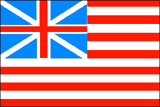 | It showed the British Union Flag of 1606, the predecessor of the Union Jack, in the canton. Its field consisted of seven red and six white alternated stripes representing the 13 colonies. The latter officially replaced it on June 14, 1777. |
Other earlier versions
| There were some other early versions of the Flag. A very popular one among them was, the first Navy Jack. It had the 13 red-white stripes with a rattlesnake overall, and the motto "Don't Tread on Me." |  |
The 1st national Flag
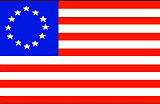 | Called the Stars and Stripes, this was formally approved by the Continental Congress--on June 14, 1777. The blue canton was to contain 13 stars, but the layout of the stars was left undefined, and several patterns are known.The one designed by the legendary Betsy Ross is said to feature the stars arranged in five rows of either two or three stars. |
The Navy adopted its own flag
| Some related designs that followed soon, include the 76 Flag. It was flown at the Battle of Bennington on Aug. 16, 1777. | 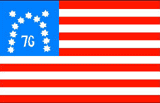 |
Hulbert's Stars and Stripes
 | Yet another contemporary flag that was cast in the mold of the Stars and Stripes was the one designed by John Hulbert, a magistrate. It's stripes were the same but the canton featured a diamond-shaped field of 13 stars was. |
The Stars and Stripes - 1795 version
| Stars and Stripes remained unchanged until May 1, 1795, when two more stars and two more stripes were added to reflect the admission to the union of Vermont (1791) and Kentucky (1792). It was this flag that inspired Francis Scott Key to write the "Star Spangled Banner". | 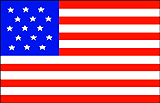 |
Stars & Stripes - 1818 version
 | In 1818, with five more states being admitted, the Congress enacted legislation. This stated that henceforth the stripes should remain 13, whereas the number of stars should always match the number of states. It was also decided that any new star should be added on the July 4 following a state's admission. This has been the system ever since. |
The 1863 version
| On May 1, 1863, a new national flag, the Stainless Banner was adopted. However, the design did not last long. | 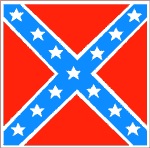 |
The 1865 version
 | But a still short lived was a modification of the Stainless Banner. It was adopted, rather futilely, about a month before the end of the war in April 1865. |
Stars and Stripes - standardized version
| Since then every time a new state was annexed, the size of the canton, as well as the stripes got altered, so as to accommodate the increased number of stars. It took to Oct. 29, 1912, when an executive order standardized the proportions and relative sizes of the elements of the flag. |  |
The national flag which we see these days has been effective since July 4, 1960. This was following the inclusion of Hawaii in the United States of America. However, this flag featuring 50 stars on a canton against the background of 13 stripes - 7 red and 6 white - has been evolved through a long period of eventful years.
Though the Flag Day was first celebrated in 1877, with the centennial of the U.S. flag's existence, the idea of making it a public celebration is believed to have originated in 1885.
In course of time a number of individuals and organizations advocated the adoption of a national day of commemoration for the U.S. Flag. However, B.J. Cigrand, a teacher from the Wisconsin Public School, District 6, is believed to be a forerunner of the thought. He organized the pupils in the Fredonia, to observe June 14 as 'Flag Birthday'. It was the 108th anniversary of the official adoption of The Stars and Stripes, the first national flag of the United States. It was a bid to inspire and educate the school children with spirit of the Flag as well as love for the nation. And it was not a single shot bid. Cigrand continued to advocate the need for its observance in the following years through numerous magazines and newspaper articles and public addresses. But the celebration was yet to take off in a well defined style and in a wider scale.
On June 14, 1889, George Balch, a kindergarten teacher in New York City, planned appropriate ceremonies for the children of his school, and his idea of observing Flag Day was later adopted by the State Board of Education of New York. On June 14, 1891, the Betsy Ross House in Philadelphia held a Flag Day celebration, and on June 14 of the following year, the New York Society of the Sons of the Revolution, celebrated Flag Day.
Inspired by Colonel J Granville Leach, a historian, the Pennsylvania Society of Colonial Dames of America adopted a resolution on April 25, 1893. The resolution requested the mayor of Philadelphia and all others in authority and all private citizens to display the Flag on June 14th. Leach went on to recommend that thereafter the day be known as 'Flag Day'. It was also recommended that on that day, school children be assembled for appropriate exercises, with each child being given a small Flag.
As a result of the resolution, Dr. Edward Brooks, then Superintendent of Public Schools of Philadelphia, directed that Flag Day exercises be held on June 14, 1893 in Independence Square. School children were assembled, each carrying a small Flag, and patriotic songs were sung and addresses delivered.
In 1894, the governor of New York directed that on June 14 the Flag be displayed on all public buildings. Meanwhile, with BJ Cigrand and Leroy Van Horn as the driving force, the Illinois organization, known as the American Flag Day Association, came into being. Its purpose was to promote the holding of Flag Day exercises. And thanks to its initiative, on June 14th, 1894, the first general public school children's celebration of Flag Day in Chicago was held. More than 300,000 children participated in the programs held various parks across Chicago. Adults, too, participated in patriotic programs in different parts of the country. And the celebration registered increasing popularity as more and more localities and states over the next three decades.
The Proclamation of President Woodrow Wilson established it officially on May 30th, 1916. While Flag Day was celebrated in various communities for years following Wilson's proclamation, it was not until August 3rd, 1949, the 14th of June was designated by President Harry Truman as National Flag Day to be celebrated each year across the nation.












No comments:
Post a Comment